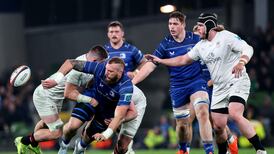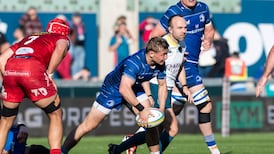Perception is, perhaps, everything. Coming hard on the heels of defeats to Glasgow and a second-string Ulster at the tail end of last season were losses to Edinburgh and the Ospreys at the start of this, with Munster's sole win in a run of five games at Thomond Park being against Zebre.
Hence, the sight of empty terraces behind either goal for their home derby against Ulster last Friday merely reinforced the feeling that Munster's once-impenetrable Limerick fortress has lost much of its lustre.
As Denis Hickie said on Second Captains yesterday, it was simply "sad to see" empty north and south terracing at the ground for Munster's 21-20 win over Ulster which, presumably, would be the second-biggest Pro12 game of the campaign after the visit of great rivals Leinster.
In as much as one can accurately assess things, thanks to the league’s misleading and irritating policy of including all ticket sales in match attendances (which therefore discredits them as “attendances”) no fixture seems to emphasise the fall-off in Munster’s support more than their annual home game with Ulster.
For five seasons from 2008-09, when Thomond Park reopened its doors as a 26,000-capacity stadium, Ulster visited the venue on six occasions, never drawing less than 22,000 spectators save for the 19,362 crowd which attended the last home league match of the 2011-12 season, and which came just four weeks after Ulster's seismic Heineken Cup quarter-final win at the same venue.
Last Friday’s “attendance” was officially recorded as 17,101, which means that 12-13,000 actually attended. That is clearly some way off those aforementioned highs.
That Munster's support has fallen away since the relatively golden years of 2000-2008, when the province reached four Heineken Cup finals and won two to spawn the Red Army, is hardly surprising and can be attributed to a myriad of factors.
Black spots
Limerick has been hit hard by the recession and the city itself has a number of the worst unemployment black spots in the country, which is perhaps even more significant given Munster’s rugby demographic is broader than Leinster’s and Ulster’s. Added to this is the additional travel costs for supporters outside of Limerick.
Given there has not been one major European final since 2009, there was always going to be the reverse of a bandwagon effect. The Red Army has been on the road since 2000 and the wonder is it lasted so long. Losing the final in 2000 and ’02 sustained the Red Army’s crusade, but having twice reached their holy grail, there isn’t the same hunger as of yore.
With the comparative lack of success has come a lack of star names, with only Paul O'Connell remaining of the golden era as the likes of Ronan O'Gara, Doug Howlett, David Wallace, Alan Quinlan and Anthony Foley himself moved into retirement. In any event, the novelty has worn off a little.
Yet Munster attendances, both real and those including non-attending season ticket holders, are holding up well this season. Compared to the corresponding first four league games (Edinburgh, Zebre, Ospreys and Scarlets) at Thomond Park, sales are fractionally down but actual attendances have increased. Ticket sales for the Ulster game (17,101) were up on last season (16,436), as, again, was the actual attendance.
The “perception” is discoloured by Musgrave Park being closed for redevelopment, thus obliging Munster to play all their home games at Thomond Park, which will always have more empty seats than their Cork home. Munster maintain that closing off both the north and south terracing, to concentrate numbers on the east and west terracing in front of the two stands, improves the atmosphere, although one could argue the value of this given how awful it looks on television.
This has also served to dilute Thomond Park's more selective, "big game" feel. Yet the latter sense of occasion remains for European games. By this morning, it's likely that the last 300 terrace tickets for next weekend's European Cup showdown at home to Clermont Auvergne will be sold, and since it is in a more favourable Saturday teatime slot, there will most likely be fewer empty seats than was the case for the October "sell-out" against Saracens.
Trek to Marseilles
Furthermore, the core of the travelling Red Army has remained strong, with up to 8,000 red-shirted fans invading Kingsholm last season in the group stages and an estimated 6,500 making the trek to Marseilles (despite no direct flights) for the semi-final against Toulon.
That is fairly remarkable, and according to Killester Travel's Paddy Baird, about 1,200 Munster fans will be in Clermont the weekend after next, which is an increase on recent years for December away fixtures – and that despite it being on a Sunday.
That supporters will vote with their feet when a team is both winning and has some marquee players in their ranks is ably underlined by Connacht this season. Their average attendance for their opening five games has been 5,280, compared to 4,362 for their first five home League games last season. The contrast has been particularly striking for the recent games against Zebre (Mils Muliaina’s debut) and the Scarlets (home debuts for Bundee Aki and Tom McCartney) which drew “attendances” of 5,486 and 5,631 – up by 1,402 and 1,559 on the corresponding fixtures last season when the Scarlets visited only a week earlier.
Sixth win
It should be noted that against the Scarlets Connacht were recording their sixth win in nine league games this season to stand in the top half of the table (they are unbeaten in six competitive games at the Sportsground this season), whereas at this juncture last season they’d lost eight in a row.
As is true of any team anywhere in any sport on the planet, it helps when you’re winning.
gthornley@irishtimes.com












